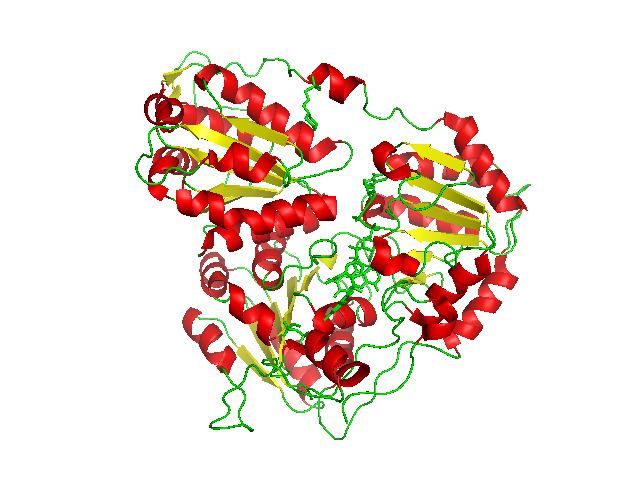EC number 2.2.1.6 ExPASy NiceZyme view | CAS number 9027-45-6 | |
 | ||
The acetolactate synthase (ALS) enzyme (also known as acetohydroxy acid synthase, or AHAS) is a protein found in plants and micro-organisms. ALS catalyzes the first step in the synthesis of the branched-chain amino acids (valine, leucine, and isoleucine).
Contents
- Gene
- Protein
- Function
- Catalytic activity
- Inhibitors
- Regulation
- Clinical significance
- Interactions
- References
It is a human protein of yet unknown function, sharing some sequence similarity with bacterial ALS, and is encoded by the ILVBL gene.
Gene
Human ILVBL gene has 17 exons resides on chromosome 19 at q13.1.
Protein
Acetolactase is a protein consisting of 590 residues. These residues are classified into three separate subunits. The units are d1yhya1, d1yhya2, and d1yhya3. This is classified by the SCOP domain assignments.
The structure of acetolactate synthase that was used for the picture on this page was determined using X-ray diffraction at 2.70 angstroms. X-ray diffraction uses X-rays at specified wavelengths to produce patterns, as the X–ray is scattered in certain ways that give an idea to the structure of the molecule being analyzed.
There are five specific ligands that interact with this protein. The five are listed below.
Function
This certain protein is an enzyme involving catalytic activity, to be more specific, a part of the biosynthesis of various amino acids. This enzyme has the Enzyme Commission Code is 2.2.1.6, which means that the enzyme is a transketolase or a transaldolase, which is classified under the transferases that transfer aldehyde or ketone residues. In this case, acetolactase synthase is a transketolase, which moves back and forth, having both catabolic and anabolic forms. These act on a ketone (pyruvate) and can go back and forth in the metabolic chain. These are found in humans, animals, plants, and bacteria. In plants, they are located in the chloroplasts in order to help with the metabolic processes. In several experiments, it has been shown that mutated strains of Escherichia coli K-12 without the enzyme were not able to grow in the presence of only acetate or oleate as the only carbon sources.
Catalytic activity
Acetolactate synthesis, also known as acetohydroxy acid synthase, is an enzyme specifically involved in the chemical reaction involving the conversion of two pyruvate molecules to an acetolactate molecule and carbon dioxide. The reaction uses thiamine pyrophosphate in order to link the two pyruvate molecules. The resulting product of this reaction, acetolactate, eventually becomes valine, leucine, and isoleucine. All three of these amino acids are essential amino acids and cannot be synthesized in the organism.
This enzyme is the first of several enzymes in the biosynthesis cycle for leucine and valine, taking the initial pyruvate molecules and starting the conversion from pryuvic acid to the amino acids. The specific residue that is responsible for this is a glycine at position 511 in the protein. This is the one that requires a cofactor of TPP for its function.
There are four specific residues that are responsible for catalytic activity in this enzyme. They are listed here with cofactors required written after.
The primary sequence is listed below. Residues involved in catalytic activity are bolded. Mutagenesis of Asp428, which is crucial carboxylate ligand to Mg(2+) in the "ThDP motif", leads to a decrease in the affinity of AHAS II for Mg(2+). While mutant D428N shows ThDP affinity close to that of the wild-type on saturation with Mg(2+), D428E has a decreased affinity for ThDP. These mutations also lead to dependence of the enzyme on K(+).
Inhibitors
Inhibitors of ALS are used as herbicides that slowly starve affected plants of these amino acids, which eventually leads to inhibition of DNA synthesis. They affect grasses and dicots alike. The ALS inhibitor family includes sulfonylureas (SUs), imidazolinones (IMIs), triazolopyrimidines (TPs), pyrimidinyl oxybenzoates (POBs), and sulfonylamino carbonyl triazolinones (SCTs).
Regulation
Acetolactate synthase consists of three pairs of subunits. Each pair includes a large subunit, which is thought to be responsible for catalysis, and a small subunit for feedback inhibition. Each subunit pair is located on its own operon. Together, these operons code for several enzymes involved in branched-chain amino acid biosynthesis. Regulation is different for each operon.
The ilvGMEDA operon (encoding ALS II, branched-chain-amino-acid transaminase, dihydroxy-acid dehydratase, and threonine ammonia-lyase) is regulated by feedback inhibition in the form of transcriptional attenuation. That is, transcription is reduced in the presence of the pathway's end-products, the branched-chain amino acids.
The ilvBNC operon, which encodes ALS I and a ketol-acid reductoisomerase, is similarly regulated, but is specific to isoleucine and leucine; valine does not affect it directly.
Both the ilvGMEDA and ilvBNC operons are derepressed during shortages of the branched-chain amino acids by the same mechanism that represses them. Both of these operons as well as the third, ilvIH, are regulated by leucine-responsive protein (Lrp).
Clinical significance
CADASIL, an identified autosomal dominant condition characterized by the recurrence of subcortical infarcts leading to dementia, was previously mapped to “ILVBL” gene within a 2-cM interval, D19S226–D19S199. No recombination event was observed with D19S841, a highly polymorphic microsatellite marker isolated from a cosmid mapped to this region. No mutation was detected on this gene in CADASIL patients, suggesting that it is not implicated in this disorder.
Interactions
In the study of Escherichia coli, the FAD binding domain of ilvB has been shown to interact with ilvN and activate the AHAS I enzyme.
